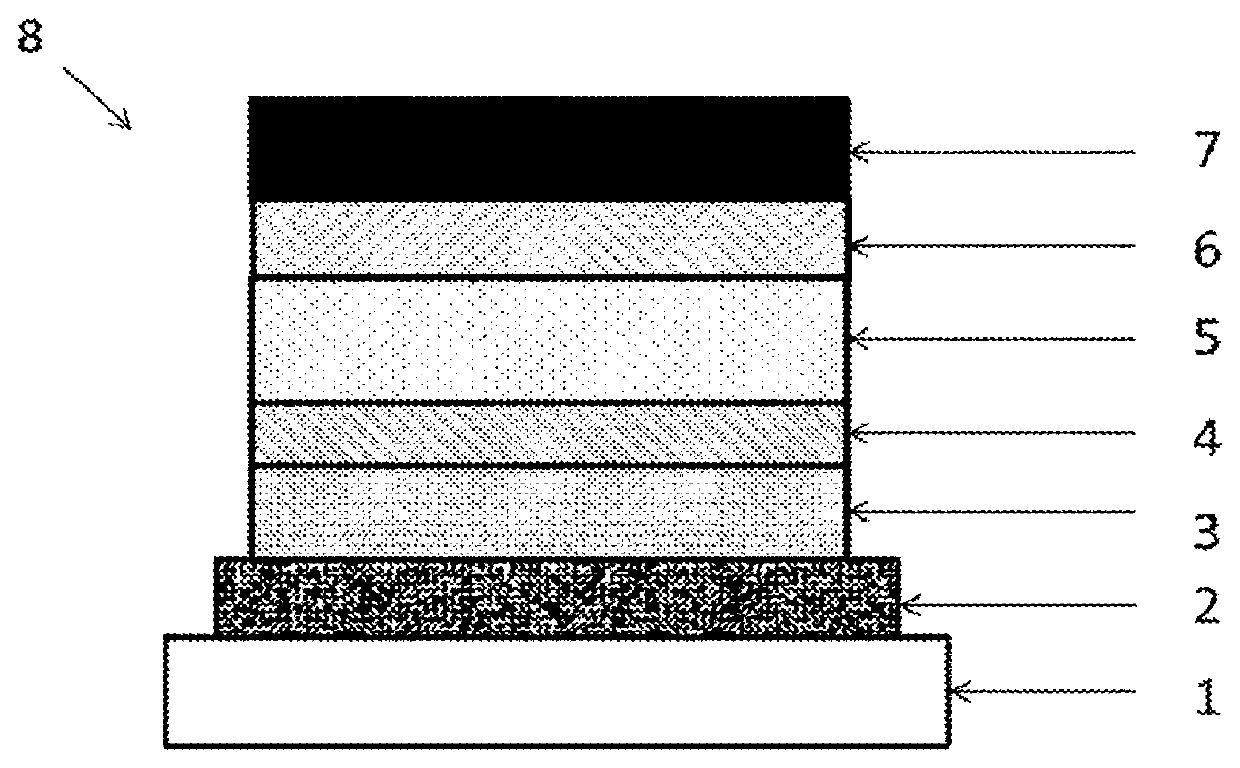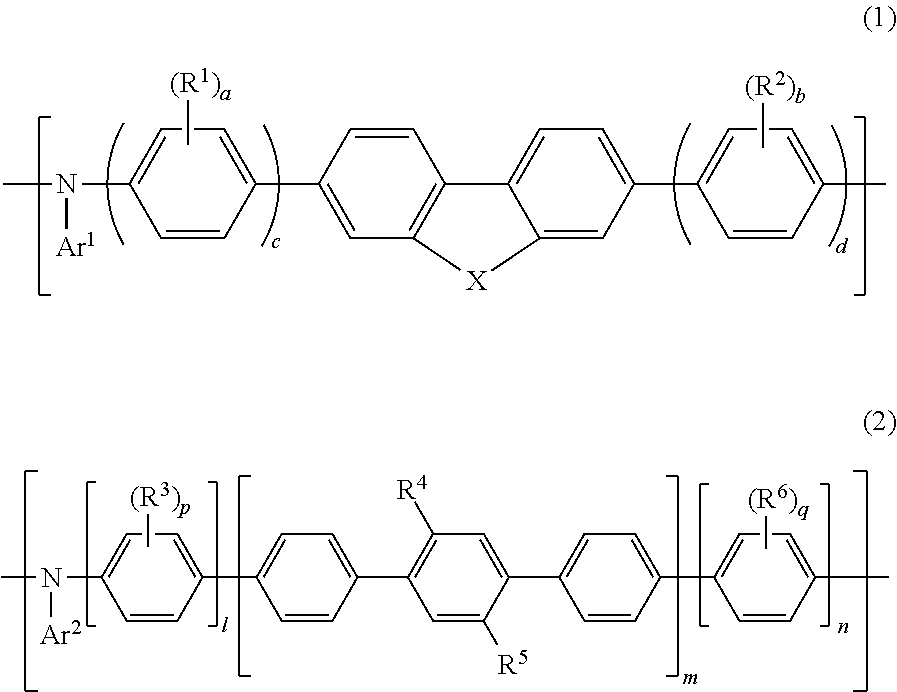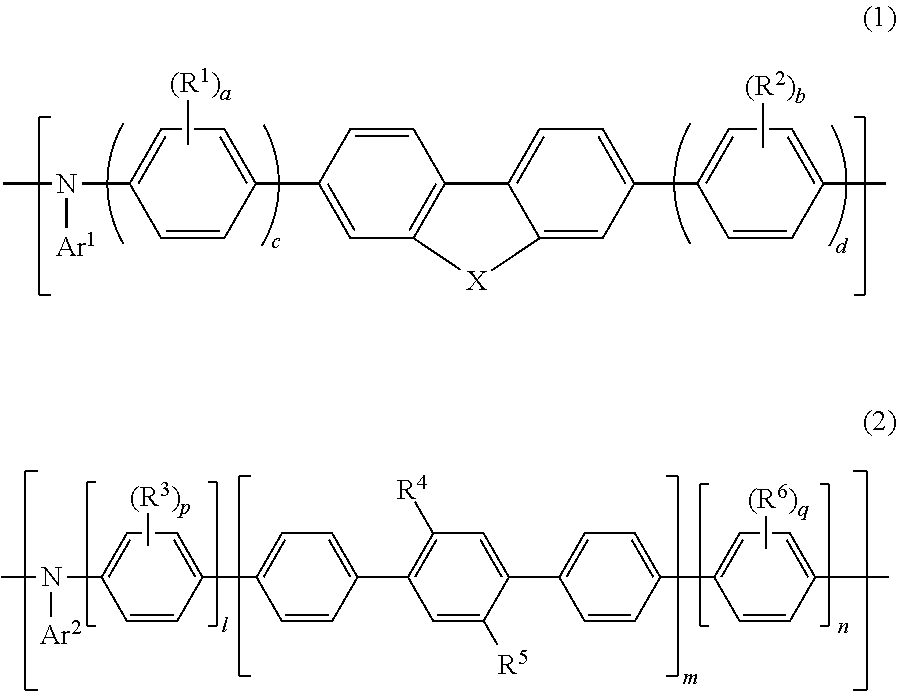Polymer, composition for organic electroluminescent element, organic electroluminescent element, organic el display device, organic el lighting, and manufacturing method for organic electroluminescent element
a technology of electroluminescent elements and polymers, applied in the field of polymers, can solve the problems of poor working stability of elements produced by wet film-forming methods and have not reached a practical level, and achieve the effects of high hole-injection/transport capacity, high brightness, and high durability
- Summary
- Abstract
- Description
- Claims
- Application Information
AI Technical Summary
Benefits of technology
Problems solved by technology
Method used
Image
Examples
specific examples
[0404]Specific examples of the polymer of the present invention that contains the repeating unit represented by Formula (1) are shown below; however, the polymer of the present invention is not restricted thereto. In the following chemical formulae, each numerical value indicates the molar ratio of the corresponding repeating unit.
[0405]The following polymers may each be, for example, a random copolymer, an alternate copolymer, a block copolymer, or a graft copolymer, and are not restricted in terms of the sequence order of the monomers.
[0406]Specific examples of the polymer of the present invention that contains the repeating unit represented by Formula (2) and specific examples of the polymer of the present invention wherein Ar2 of the repeating unit represented by Formula (2) has a structure represented by Formula (10) are shown below; however, the polymer of the present invention is not restricted thereto. In the following polymers, n and n′ each represent the number of correspo...
example 1-1
[Synthesis of Polymer 1]
[0715]A polymer 1 was synthesized in accordance with the following reaction scheme.
[0716]The compound 7 (2.00 g, 3.0 mmol), 2-amino-9,9-dimethylfluorene (1.24 g, 6.00 mmol), tert-butoxy sodium (2.20 g, 22.9 mmol), and toluene (60 g) were added to a flask, and this system was sufficiently purged with nitrogen and heated to 60° C. (solution A). To 3.1 g of a toluene solution of a tris(dibenzylidene acetone)dipalladium complex (0.054 g, 0.059 mmol) that had been prepared in a separate flask, [4-(N,N-dimethylamino)phenyl]di-tert-butyl phosphine (0.13 g, 0.48 mmol) was added, and the resultant was heated to 60° C. (solution B). In a nitrogen stream, the solution B was added to the solution A, and they were allowed to react for 1.0 hour with heating to reflux. After confirming that the monomers had disappeared, the compound 5 (1.440 g, 2.71 mmol) was added. The resultant was heated to reflux for 1 hour, and bromobenzene (0.467 g, 2.97 mmol) was subsequently added t...
example 1-2
[Synthesis of Polymer 3]
[0721]A polymer 3 was synthesized in the same manner as the polymer 1 in accordance with the following reaction scheme.
[0722]Weight-average molecular weight (Mw)=41,900
[0723]Number-average molecular weight (Mn)=31,500
[0724]Degree of dispersion (Mw / Mn)=1.33
PUM
| Property | Measurement | Unit |
|---|---|---|
| Fraction | aaaaa | aaaaa |
| Fraction | aaaaa | aaaaa |
| Fraction | aaaaa | aaaaa |
Abstract
Description
Claims
Application Information
 Login to View More
Login to View More - R&D
- Intellectual Property
- Life Sciences
- Materials
- Tech Scout
- Unparalleled Data Quality
- Higher Quality Content
- 60% Fewer Hallucinations
Browse by: Latest US Patents, China's latest patents, Technical Efficacy Thesaurus, Application Domain, Technology Topic, Popular Technical Reports.
© 2025 PatSnap. All rights reserved.Legal|Privacy policy|Modern Slavery Act Transparency Statement|Sitemap|About US| Contact US: help@patsnap.com



